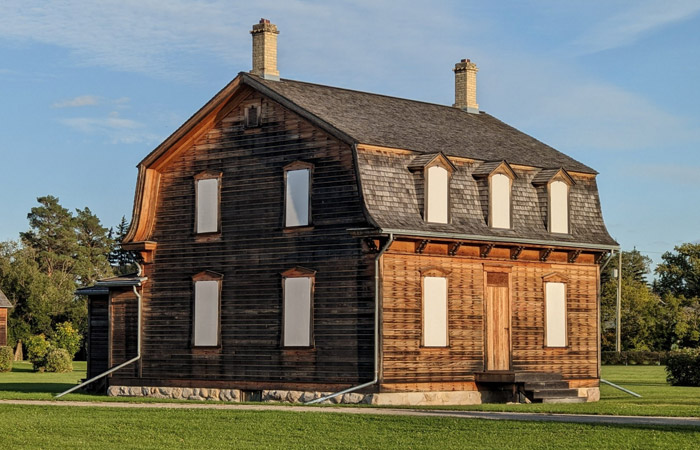Village News
Neighbours: The Red River Métis

Some of the first people the Mennonites encountered in Manitoba, already at the time of the visit by the Mennonite delegates in 1873, were the Red River Métis, who constituted the majority of the population at the time. This was about to change as European immigration surged in the next decade, and as many resident Métis left the province, disillusioned at the inept implementation of the Manitoba Act of 1870.
At the time of the visit by the delegates, the population of Manitoba was over 25,000. Of that number, the majority were of mixed First Nations and European ancestry. Fear of American expansionism had forced the British Crown to turn Ruperts Land over to Canada in 1869. The existing settlement of farmers and hunters, most of them Métis, feared for the loss of their livelihood and culture. The Canadian government exacerbated the situation in August of 1869 by re-surveying the land, including existing river lots, and appointing William McDougall, a Canadian expansionist as the first Lieutenant-Governor. With support from both English and French-speaking Métis, Louis Riel stopped the survey, barred McDougall from entering the province, conducted an election, and proclaimed a Provisional Government led by Riel. Push-back from the Anglo-Ontarians from Portage la Prairie in particular, who opposed the Provisional Government, apprehension about American expansionism, and public outcry in Eastern Canada, led to the Federal Wolseley Expedition, which arrived in Upper Fort Garry on August 24, too late to put down the opposition, for the Manitoba Act was already in effect as of July 15, 1870.
Under the shadow of the Expeditionary Force, Anglo-Ontarians exacted revenge on the Métis, with verbal and physical altercations in what has been called a “reign of terror”. Wolseley, unable or unwilling to effect civil authority, did little to discipline the perpetrators. This caused a number of Métis to move elsewhere beyond Red River westward or to Montana or attempt to blend into the Francophone Parishes. The buffalo hunt was no more, but the Métis skills as cart drivers could provide work as draymen, as shown by the transportation of the Mennonite delegates.
This was the immediate context which Mennonites entered. The arrival of the first Mennonites on the East Reserve in 1874 placed them on 8 townships of land surrounded on three sides by Red River Métis reserve land. To the northwest lay Oak Island (Ile des Chénes), and slightly further north St. Norbert, one of the largest Parishes in Manitoba. Directly to the west lay the Rat River Settlement consisting of two river lot communities, now called Otterburne and St. Pierre. St. Malo was just south of Township 5-5E along an old gravel ridge trail that led diagonally through the entire East Reserve to La Pointe des Chénes (Ste. Anne) which lay just north of Township 7-6E. The inhabitants of these communities were French-speaking Métis and/or Quebecois.
Contact with Red River Métis neighbours already began with the 1873 delegates who depended on them at various junctures in their exploration of Manitoba. Delegate Suderman reported seeing their first Métis farm just north of Emerson and being immediately encouraged to see that wheat was being farmed there. On the inspection tour of the East Reserve, they overnighted in the Hudson Bay Company store in La Pointe des Chénes (Ste. Anne), established in 1856 as the first French/Métis farm community outside of the Red River valley. They encountered Red River Métis of all walks of life on farms, in cart brigades, in overnight hostels scattered over the prairie, and in the city of Winnipeg as tradesmen and merchants.
Prior to the arrival of the first Mennonites in August of 1874, Métis men hired by Jacob Shantz constructed the four immigrations sheds 8 km east of the Rat and Red River landing, just south of present-day Niverville. Then upon arrival, Métis carters hired by William Hespeler transported the new arrivals and supplies from the steamboat landing site to the immigration sheds. Moreover, once settled into the sheds, the family heads were taken on scouting missions through the northern half of the East Reserve by Métis drivers familiar with the land, using Red River carts.
In the next phase, that of establishing villages, Mennonites relied on the Métis to survey the village sites. On the West Reserve, Roger Goulet was designated by the Province to accompany the Mennonites looking to find suitable village sites, and anecdotal evidence suggests that Goulet also surveyed the first Mennonite villages of the East Reserve.
However, reliance on the Métis did not end with the establishment of villages. In every aspect of early pioneer life, Mennonites relied on the go-to people of the area, namely the Red River Métis. Oxen and horses were bought from them, as were farm implements, food and household products, and just about anything else needed in the pioneer stage, in what was described in a letter as a “brisk trade” with the Métis in Ste. Anne, listing everything from potatoes to chickens being purchased. Since travel to Winnipeg was particularly frequent in the first three years, it was the Métis who ran the ferries across the Red River. Sometimes Mennonites hired them to cross the river at other points, so not only were the Métis indispensable for land travel but for water passage as well.
Another aspect of the new life in Manitoba was the unfamiliar flora, and the medicinal aspects provided by it. Here Mennonite midwives and healers learned from both the Métis and First Nations which plants provided what benefit.
For Mennonites on the East Reserve, Winnipeg was about a 2-day journey away. Since Ile des Chénes was about halfway between Steinbach and Winnipeg, relationships developed there for overnighting. In fact, hospitality was such a strong element in that relationship that Delegate Toews wrote, “We frequently come into contact with the Métis… Everyone who has had business with them praises their hospitality. Indeed, you can take it that, truthfully, these people often put us to shame…” Cornelius Toews, December 13, 1874, Gruenfeld MB (Pioneers and Pilgrims, Delbert Plett, 1990 p. 50.)
Migrating over international borders into a new land was not new to the Mennonites, but in the 1870s, Russian Mennonites for the first time crossed an ocean to a new continent. Here they found themselves not only in a new climate but also among unfamiliar neighbours speaking unfamiliar languages. Here they became the “strangers at the gates”, a situation clearly addressed in the Bible, where an admonition in Leviticus 19:33-34 is given to the Children of Israel regarding the appropriate treatment of strangers: “When a stranger sojourns with you in your land, you shall not do him wrong. You shall treat the stranger who sojourns with you as the native-born among you; you shall love him as yourself, for you were strangers in the land of Egypt.” The Red River Métis honoured this admonition scrupulously, and to this day one does not hear of any mistreatment of Mennonites by them, but instead they accepted us unconditionally, and made no distinctions. Mennonites remember.



